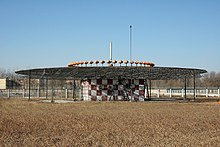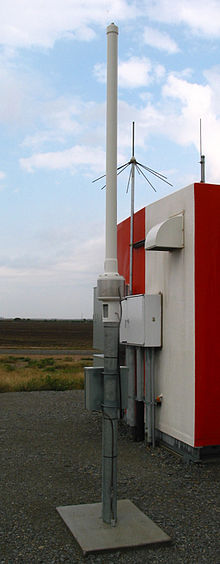User:Bgspeed/sandbox


Scanning vs Non-scanning DME
[edit]Distance measuring equipment (DME) is a transponder-based radio navigation technology that measures slant range distance by timing the propagation delay of VHF or UHF radio signals.
What are the flight deck differences between scanning and non-scanning DME?
[edit]The following description assumes Pegasus FMC with the REMOTE_TUNE_ENABLE function disabled in the OPC (remote tune function thru CDU tunes both VOR and DME) and VOR/DME control panels installed.
Scanning DME Option Disabled (Non-scanning DME):
[edit]In this mode of operation, each DME can tune only one station (in DME directed channel 1) at a time. When the DMEs are in single channel operation and there is no Manual, Procedure or Remote tuning, the FMC chooses the best available navaids for DME/DME updating. If one DME is in Manual, Procedure or Remote tuned, then the FMC will autotune the remaining DME to a station which provides the best DME/DME pair. If none are found, the FMC will downmode to VOR/DME updating. If both DMEs are Manual, Procedure or remote tuned, the FMC will attempt DME/DME updating from the tuned stations. If that is not possible, then the FMC will attempt VOR/DME updating using first the closer, then the farther of the two stations.
If a DME fails, DME/DME updating is not possible.
In this configuration, the DME is connected directly to the RDMI for the display of distance to the station that is Auto, Manual, Remote or Procedure tuned. FMC PROGRESS page 1/X ( for CDU and HMCDU installation) or FMC NAV RADIO page (for MCDU installation) will display the frequency of the associated VOR and the tuning modes: "A" = autotuned, "R" = remote tuned, "P" = procedure tuned, and "M" = manually tuned. When the EFIS control panel is in the VOR or ILS/APP modes, the VOR/DME control panel is in the manual mode. When the EFIS control panel is in the MAP or PLAN mode, autotune is the mode, with manual mode selectable by the flight crew via the VOR/DME control panel.
Each FMC receives and uses distance data from the left and right DME interrogators. The master FMC generates tuning commands which go to the DMEs and VORs.
Scanning DME Option Enabled:
[edit]A single DME interrogator, when operated in the scanning mode, is capable of computing distance data for up to five stations simultaneously. Each FMC normally uses the data provided by it's onside DME. If, however, an FMC's onside DME fails or is forced to operate in the single channel directed mode due to Manual tuning, the FMC will use DME/DME data provided by its offside DME if it is in the scanning mode of operation. If both DMEs are in the single channel directed mode due to Manual tuning, the FMC recognizes scanning DME is not available and will attempt DME/DME updating from the tuned stations. If that is not possible, then the FMC will attempt VOR/DME updating using first the closer, then the farther of the two stations.
The DME/DME pair, if available, will be tuned in DME directed channels 1 and 2. Data from this pair is used for DME/DME radio position computation. Channels 3 and 4 are used to tune the DME portion of the tuned VORs. DME directed channel 3 is reserved for tuning the DME associated with VOR-L and DME directed channel 4 is reserved for tuning the DME associated with VOR-R. The fifth DME channel tunes the DME co-located with an ILS when the ILS has been manually tuned via the ILS CP.
The following order of priority applies for tuning the VORs:
[edit]- Frequency manually tuned via the control panel
- Remote tuned navaid frequency via the CDU
- Procedure tuned navaid frequency
- Frequency of closest collocated VOR/DME or VOR/TACAN within 250nm of the airplane
- Park the VOR frequency
The source of distance data for display on the RDMI depends upon if the VOR control panel is in auto or manual tune. When in manual tune, the DME is in a single channel directed mode, and is connected to the RDMI for providing the distance data. When in auto tune (DME in scanning mode), relays switch the source from the DME to the FMC to prevent the cycling of distances as the DME scans thru the channels. The left FMC outputs the distance data for the DME associated with the VOR-L tuned in channel 3. The right FMC outputs the distance data for the DME associated with the VOR-R tuned in channel 4. FMC PROGRESS page 1/X ( for CDU and HMCDU installation) or FMC NAV RADIO page (for MCDU installation) will display the frequency of the associated VOR and the tuning modes: "A" = autotuned, "R" = remote tuned, "P" = procedure tuned, and "M" = manually tuned. When the EFIS control panel is in the VOR or ILS/APP modes, the nav control panel is in the manual mode. When the EFIS control panel is in the MAP or PLAN mode, autotune is the mode, with manual mode selectable by the flight crew via the nav control panel.
Each FMC receives and uses distance data from the left and right DME interrogators. The master FMC generates tuning commands which go to the DMEs and VORs.
Major Differences Between Scanning and Non-Scanning:
[edit]A. In the scanning DME config, DME distance display on RDMIs (and CDUs) typically not associated with DMEs being used for DME/DME updating.
B. In the scanning DME config, when the Left or Right VOR/DME control panel is not in Manual, the FMC retransmits the left DME distance (from DME directed channel 3) or right DME distance (from DME directed channel 4) to the RDMIs. They are correspondent to the navaid which is being tuned on the Left VOR or Right VOR fields respectively (see VOR tuning logic above). Note, if both VOR panels are in autotune, no navaids are being remotely tuned through the FMC CDU, and a procedure tuned navaid is not required, then both the left and right VORs will be tuned to the same navaid as specified in item 4 (this operation was previously communicated to DAL in the reference /B/ telex).
C. In the scanning DME config, FMC automatically tunes best available DME pair for FMC position updating and provides additional channels for manual tuning of additional VORs with no affect on DME updating.
D. In non-scanning DME config, failure of a DME interrogator, results in loss of DME/DME update capability. In scanning config, full DME/DME updating capability exists with a single failed DME interrogator when the remaining operational DME is in the scanning mode.
E. In non-scanning DME config, setting one DME to manual tuning limits DME/DME update capability. In scanning config, full DME/DME updating capability exists when one DME is manually tuned and the when the remaining operational DME is in the scanning mode.
